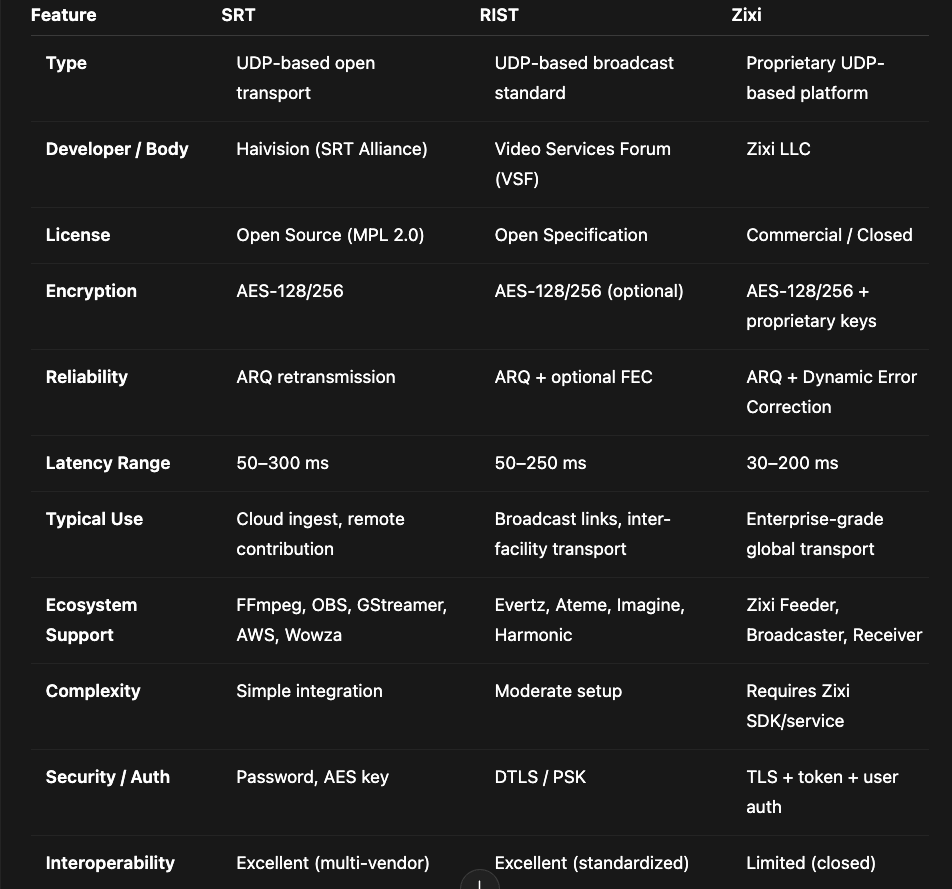
Part | Function
ST 2110-10: System timing, definitions, synchronization, referencing PTP and SDP.
ST 2110-20: Transport of UNcompressed VIDEO essences.
ST 2110-21: Timing constraints, traffic shaping / pacing (to control bursts, buffer behavior) for video.
ST 2110-22: Transport of constant bit-rate compressed video (e.g. JPEG XS) as an alternative to fully uncompressed.
ST 2110-30: Transport of UNcompressed PCM AUDIO, referencing AES67 ST 2110-31: Transport of AES3 (with status bits) over IP — for audio or data requiring AES3 format.
ST 2110-40: Transport of ancillary data / metadata / embedded non-video data (e.g. VANC, HDR metadata).
ST 2110-41 / ST 2110-43: Additional metadata / timed text / flexible payload formats.
SMPTE 2110 architecture differs from SDI or from combined streams (MPTS/SPTS)
SDP (Session Description Protocol) FILE is a plain-text file that tells receiving devices how to connect to and interpret an IP media stream.
It describes: where to receive the stream (IP address, port, multicast info) what codec and payload format is used
what timing/sync info applies
how the stream aligns with others (video, audio, metadata)
SDP is defined in RFC 4566 and used with RTP/UDP multicast or unicast transport.
Why SMPTE 2110 Uses SDP
SMPTE 2110 carries elementary streams separately:
Video (2110-20 or 2110-22)
Audio (2110-30 or 2110-31)
Ancillary data (2110-40)
Each stream (called an essence flow) needs an SDP to define how it should be received and synchronized.
Receivers (e.g., video switchers, monitors, intercoms) use the SDP to “subscribe” to the correct multicast group and decode it properly.
Clock Synchronization
2110 relies on PTP (IEEE 1588-2008 / SMPTE 2059) for frame-accurate sync. The SDP references that timing domain via:”
In Summary
Concept | Description
PurposeDescribe the session parameters of a 2110 essence flow
Format Plain-text, defined in RFC 4566
Contains Multicast address, port, codec type, resolution, frame rate, clock reference
Generated by Encoder or network controller (IS-04/IS-05)
Consumed by Receivers or monitoring systems
Sync reference PTP (SMPTE 2059), declared in SDP
Optical transport: real-time media transport of video, audio, data, intercom, Ethernet and sync signals over fiber
Bi-directional
Close to zero latency
Short and long distances: suitable for use in studios, outside broadcast or contribution (even distances over 100km)
High density: up to 240 HD-SDI signals over a single fiber
Multiplexing: supports electrical multiplexing prior to optical conversion, and both WDM and DWDM optical multiplexing
Media conversion: Wide range of media converters from single channel electrical to optical converter for video or Ethernet signals, to 36-channel compact 1RU converter unit
Redundancy: optical switching and splitting to create redundant paths
Low power consumptiong
SRT (Secure Reliable Transport):
An open-source protocol optimized for low-latency streaming over unreliable networks.
Includes features like forward error correction and encryption to ensure reliable delivery.
SRT (Secure Reliable Transport) a replacement of RTMP. It’s a royalty-free, open-source video streaming transport protocol that delivers secure low-latency streaming performance over noisy or unpredictable (lossy) networks such as the public internet. SRT uses an intelligent packet retransmit mechanism called ARQ (Automatic Repeat reQuest) on top of a UDP data flow to protect against packet loss and fluctuating bandwidth, as well as to ensure the quality of your live video.
SRT (Secure Reliable Transport) is codec agnostic and can stream any type of video content.
Benefits of using the SRT protocol
Streaming video over the internet can be a challenge due to unpredictable network conditions, including unstable connections, bandwidth limitations, and latency issues. SRT supports:
Pristine quality video – SRT is designed to protect against jitter, packet loss,and bandwidth fluctuations due to congestion over noisy networks for the best viewing experience possible. This is done through advanced low latency retransmission techniques that compensate for and manage the packet loss. SRT can withstand up to 10% packet loss with no visual degradation to the stream.
Low latency – In spite of dealing with network challenges, video and audio is delivered with low latency. It has the combined advantages of the reliability of TCP/IP delivery and the speed of UDP.
Secure end-to-end transmission – Industry-standard AES 128/256-bit encryption ensures protection of content over the internet. SRT provides simplified firewall traversal.
Leveraging the internet – Because SRT ensures security and reliability, the public internet is now viable for an expanded range of streaming applications—like streaming to cloud sites (for example, LiveScale omnicast multi-cloud platform’s concurrent distribution to multiple social media such as Facebook Live, YouTube, Twitch, and Periscope from one live video feed), streaming or remoting an entire video wall content, or regions of interest of a video wall.
Interoperability – Users can confidently deploy SRT through their entire video and audio streaming workflows knowing that multi-vendor products will work together seamlessly.
Open source – Royalty-free, next-generation open-source protocol leads to cost-effective, interoperable, and future-proofed solutions.
SMPTE 2110 offers a significant advantage by enabling the transmission of up to 8 separate 1080p VIDEO streams over a single 25 GB fiber cable. This capability not only optimizes cable utilization but also enhances overall system flexibility, allowing for the simultaneous transport of multiple high-definition video streams, thereby maximizing efficiency and reducing infrastructure complexity.
SMPTE 2110 servers also enable greater scalability in media production through their increased flexibility and agility.

